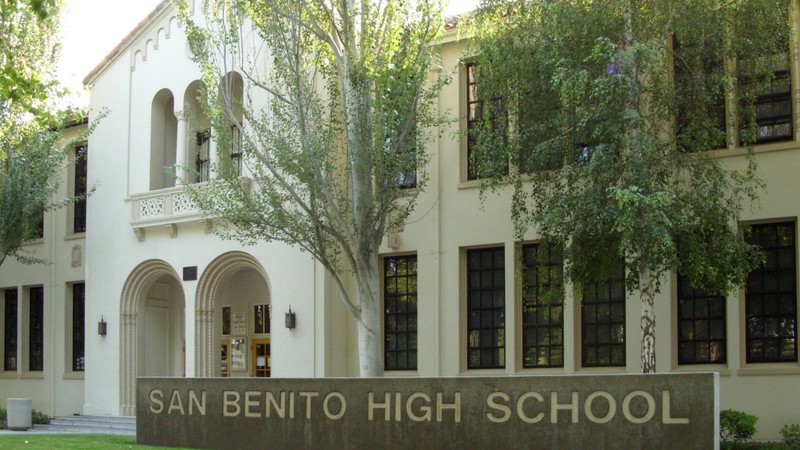The largely rural county educates more than 11,000 students in its 11 districts.

San Benito High School District serves more than 3,000 students. Michael Patrick / Wikimedia Commons Public Domain
Writing back in 1881, in a 289-page book titled History of San Benito County, California—a history that extended back just seven years, the county having been founded in 1874—the uncredited author waxed enthusiastic about the public school in the Hollister (then, as now, the county seat).
“Hollister has as well-managed and progressive a public school as can be found in the state,” the author wrote (the book was credited only to its San Francisco publisher, Elliot & Moore). “A perfect system exists from the Primary to the principal’s department.”
The author went on to lavish praise on Miss Lula L. Moore, head of the Grammar department, for her “reputation of being the best disciplinarian that has ever taught in the school,” and noted that “the work that is being done by the teachers is entirely satisfactory,” concluding that Hollister was graced with “one of the best schools in the state.”
At the time, according to the History author, the single school had an enrollment of 261 pupils, 227 of whom were in attendance on an average day.
By 2020, the Hollister School District had 11 schools with an enrollment of 6,388 students, according to Education Data Partnership stats. And one of those schools—the Accelerated Achievement Academy—is among the 11th in the 2021 U.S. News and World Report rankings of California elementary schools. That rating was based on the performance of the school’s 199 students in grades four through eight on statewide tests, their graduation rate, and their preparation for high school.
The site Public School Review also placed Accelerated Achievement Academy in the top 1 percent of elementary schools nationwide, based on similar criteria, giving a rating of “10” on a scale of one through 10.
Among the 10 other school districts serving San Benito County’s approximately 11,500 public school students are some of the state’s smallest school districts. There’s Cienega Union Elementary, with just 29 students, and Bitterwater-Tully Elementary—a remotely located school about an hour outside of Hollister—with 34. But those districts are titans compared to California’s two smallest school districts, both in San Benito County. One of those is Panoche Elementary, about an hour’s drive southwest of Hollister in the tiny, unincorporated community of Paicines, with seven students. And then there's Jefferson Elementary, about 45 minutes southeast of Hollister, with just six students enrolled for the 2020-2021 school year.
On the other end of the spectrum, San Benito High School District has 3,350 students between its two schools. In addition to San Benito High, the Hollister-based district also includes San Andreas Continuation High, with 64 students. A continuation high school, as described by the state department of education, “is an alternative high school diploma program … for students who are 16 years of age or older, have not graduated from high school, are still required to attend school, and who are at risk of not graduating.” That includes students who have fallen behind in their credits, or simply need a flexible school schedule due to the need to hold a job, or family obligations.
At least through 2022, all 11 districts come under the supervision of county Office of Education Superintendent Krystal Lomanto, who was first elected to the job in 2014, then reelected in 2018. Like all but five of California’s counties, San Benito votes for its superintendent. Lomanto is a Hollister native who graduated from San Benito High and later served as the school’s principal before running for the county’s top education post.
Though typically the superintendent’s job focuses on securing federal and local funding for county schools, like superintendents throughout the state and the country, Lomanto was faced with the significant challenge of keeping the county educational system running throughout the COVID-19 pandemic.
In a rural county, however, San Benito faced obstacles different from those in more densely populated urban and suburban regions. As schools shifted to online-based “distance learning,” the depth of the county’s “digital divide” was painfully exposed. Not only were families of some students unable to afford quality internet connectivity, swaths of county territory were not connected to an online service provider at all.
“It is a huge social injustice,” Lomanto told the student-journalism site Reynolds Sandbox. “Every student should have connectivity. It should be a right, it shouldn’t be a privilege. And so distance learning really opened up that can of worms and realized that, wow, we have a huge gap.”
Long form articles which explain how something works, or provide context or background information about a current issue or topic.